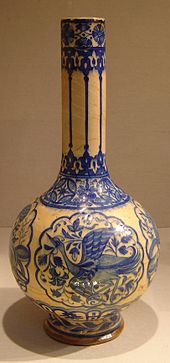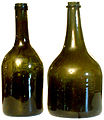
A soft drink is any water-based flavored drink, usually but not necessarily carbonated, and typically including added sweetener. Flavors used can be natural or artificial. The sweetener may be a sugar, high-fructose corn syrup, fruit juice, a sugar substitute, or some combination of these. Soft drinks may also contain caffeine, colorings, preservatives and other ingredients.
A screw cap or closure is a common type of closure for bottles, jars, and tubes.
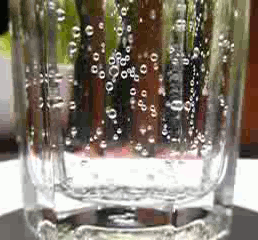
Carbonated water is water containing dissolved carbon dioxide gas, either artificially injected under pressure or occurring due to natural geological processes. Carbonation causes small bubbles to form, giving the water an effervescent quality. Common forms include sparkling natural mineral water, club soda, and commercially produced sparkling water.

A carboy, also known as a demijohn or a lady jeanne, is a rigid container with a typical capacity of 4 to 60 litres. Carboys are primarily used for transporting liquids, often drinking water or chemicals.

A wine bottle is a bottle, generally a glass bottle, that is used for holding wine. Some wines are fermented in the bottle while others are bottled only after fermentation. Recently the bottle has become a standard unit of volume to describe sales in the wine industry, measuring 750 millilitres. Wine bottles are produced, however, in a variety of volumes and shapes.

A bottle cap or bottle top is a closure for the top opening of a bottle. A cap is sometimes colorfully decorated with the logo of the brand of contents. Plastic caps are used for plastic bottles, while metal with plastic backing is used for glass; plastic caps are commonly made from polyethylene or polypropylene, while metal caps are usually either steel or aluminum. Plastic caps may have a pour spout. Flip-Top caps like Flapper closures provide controlled dispensing of dry products. Caps for plastic bottles are often made of a different type of plastic from the bottle.

A stopper, bung, or cork is a cylindrical or conical closure used to seal a container, such as a bottle, tube, or barrel.

Ramune is a Japanese carbonated soft drink. It was introduced in 1884 in Kobe by the Scottish pharmacist Alexander Cameron Sim. Ramune is available in a Codd-neck bottle, a heavy glass bottle whose mouth is sealed by a round marble due to the pressure of the carbonated contents. The name ramune is derived from a Japanese borrowing of the English word lemonade.
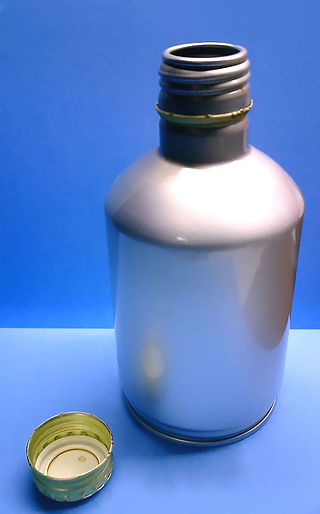
A closure is a device used to close or seal a container such as a bottle, jug, jar, tube, or can. A closure may be a cap, cover, lid, plug, liner, or the like. The part of the container to which the closure is applied is called the finish.

Container-deposit legislation is any law that requires the collection of a monetary deposit on beverage containers at the point of sale and/or the payment of refund value to the consumers. When the container is returned to an authorized redemption center, or retailer in some jurisdictions, the deposit is partly or fully refunded to the redeemer. It is a deposit-refund system.
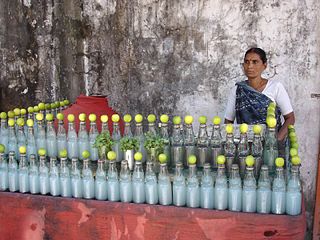
Banta Soda, or Banta, also Goli Soda or Goti Soda and Fotash Jawl, is a popular carbonated lemon or orange-flavoured soft drink sold in India since the late 19th century in a distinctly shaped iconic Codd-neck bottle. The pressure created by the carbonated liquid seals the bottle by forcing a glass marble up into the neck of the bottle where it snugly locks into a rubber gasket. Opening the bottle by pressing on the marble thus releasing the pressurised gas is seen to be a fun experience. The drink is easily available at street-sellers, known as bantawallahs, at prices ranging from ₹5 (6.0¢ US) – ₹30 (36¢ US). The drink is sold in glass tumblers and plastic cups, and used to be served in kulhars.
Wine accessories are things that may be used in the storage or serving of wine. Wine accessories include many items such as wine glasses, corkscrews, and wine racks.

A glass bottle is a bottle made from glass. Glass bottles can vary in size considerably, but are most commonly found in sizes ranging between about 200 millilitres and 1.5 litres. Common uses for glass bottles include food condiments, soda, liquor, cosmetics, pickling and preservatives; they are occasionally also notably used for the informal distribution of notes. These types of bottles are utilitarian and serve a purpose in commercial industries.

A jug is a type of container commonly used to hold liquids. It has an opening, sometimes narrow, from which to pour or drink, and has a handle, and often a pouring lip. Jugs throughout history have been made of metal, ceramic, or glass, and plastic is now common.

A plastic bottle is a bottle constructed from high-density or low density plastic. Plastic bottles are typically used to store liquids such as water, soft drinks, motor oil, cooking oil, medicine, shampoo, milk, ink, etc. They come in a range of sizes, from very small bottles to large carboys. Consumer blow molded containers often have integral handles or are shaped to facilitate grasping.

Container glass is a type of glass for the production of glass containers, such as bottles, jars, drinkware, and bowls. Container glass stands in contrast to flat glass and glass fiber.

Hiram Codd was an English engineer and inventor. In 1872, he patented a bottle filled under gas pressure which pushed a marble against a rubber washer in the neck, creating a seal for soft drinks. This became known as the Codd bottle.
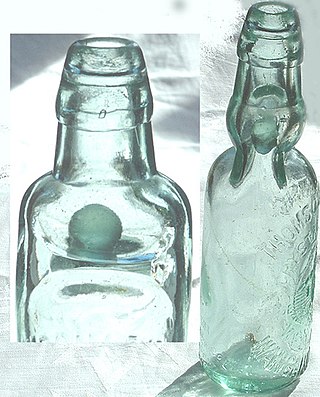
A Codd-neck bottle is a type of bottle used for carbonated drinks. It has a closing design based on a glass marble which is held against a rubber seal, which sits within a recess in the lip.
